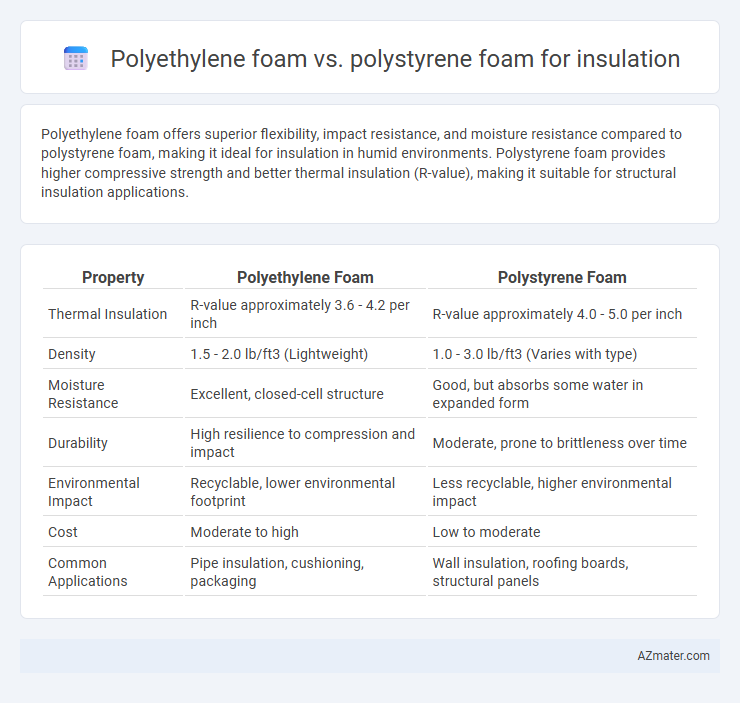Polyethylene foam offers superior flexibility, impact resistance, and moisture resistance compared to polystyrene foam, making it ideal for insulation in humid environments. Polystyrene foam provides higher compressive strength and better thermal insulation (R-value), making it suitable for structural insulation applications.
Table of Comparison
| Property | Polyethylene Foam | Polystyrene Foam |
|---|---|---|
| Thermal Insulation | R-value approximately 3.6 - 4.2 per inch | R-value approximately 4.0 - 5.0 per inch |
| Density | 1.5 - 2.0 lb/ft3 (Lightweight) | 1.0 - 3.0 lb/ft3 (Varies with type) |
| Moisture Resistance | Excellent, closed-cell structure | Good, but absorbs some water in expanded form |
| Durability | High resilience to compression and impact | Moderate, prone to brittleness over time |
| Environmental Impact | Recyclable, lower environmental footprint | Less recyclable, higher environmental impact |
| Cost | Moderate to high | Low to moderate |
| Common Applications | Pipe insulation, cushioning, packaging | Wall insulation, roofing boards, structural panels |
Introduction to Polyethylene and Polystyrene Foams
Polyethylene foam is a closed-cell, lightweight material known for its excellent thermal insulation, moisture resistance, and impact absorption, making it ideal for packaging and building insulation. Polystyrene foam, available as expanded (EPS) or extruded (XPS), offers rigid thermal insulation with high compressive strength and moisture resistance, commonly used in wall, roof, and foundation applications. Both foams provide energy efficiency and durability, but differ in density, flexibility, and moisture permeability, influencing their suitability for specific insulation needs.
Chemical Composition and Structure Differences
Polyethylene foam consists of long chains of ethylene monomers, creating a flexible, closed-cell structure that provides excellent thermal insulation and moisture resistance. Polystyrene foam is made from styrene monomers, forming a rigid, open or closed-cell structure that offers higher compressive strength but less flexibility compared to polyethylene. The chemical composition of polyethylene contributes to its durability and resilience, while polystyrene's aromatic structure enhances its rigidity and insulating properties.
Thermal Insulation Performance Comparison
Polyethylene foam offers superior thermal insulation due to its closed-cell structure, which minimizes heat transfer and provides higher R-values compared to polystyrene foam's often more porous composition. Polystyrene foam, while commonly used for insulation, generally exhibits lower thermal resistance and can be more susceptible to moisture absorption, decreasing its insulating effectiveness. Polyethylene's enhanced durability and moisture resistance contribute to maintaining consistent thermal performance over time, making it preferable for applications requiring long-lasting insulation.
Moisture Resistance and Water Absorption
Polyethylene foam exhibits superior moisture resistance and significantly lower water absorption compared to polystyrene foam, making it ideal for insulation in damp environments. Its closed-cell structure prevents water infiltration, maintaining thermal performance and structural integrity over time. Conversely, polystyrene foam tends to absorb more moisture, which can compromise insulation efficiency and lead to potential mold growth.
Mechanical Strength and Durability
Polyethylene foam exhibits superior mechanical strength compared to polystyrene foam, offering enhanced resistance to compression and impact, making it ideal for applications requiring durability under stress. Polystyrene foam offers good thermal insulation but is more brittle and prone to cracking or crumbling under mechanical pressure. For long-term durability, polyethylene foam outperforms polystyrene foam due to its higher tensile strength, flexibility, and resistance to moisture and chemicals.
Fire Resistance and Safety Ratings
Polyethylene foam typically exhibits lower fire resistance compared to polystyrene foam, as it can melt and ignite more easily under high heat conditions, thus posing greater fire safety concerns. Polystyrene foam, especially in its expanded (EPS) or extruded (XPS) forms, is often treated with fire retardants to meet rigorous safety standards such as ASTM E84 Class A or B ratings, making it a safer option for building insulation. Fire safety ratings and the material's behavior under flame exposure are critical factors for selecting foam insulation to ensure compliance with building codes and reduce fire hazards in residential or commercial applications.
Environmental Impact and Recyclability
Polyethylene foam and polystyrene foam differ significantly in environmental impact and recyclability, with polyethylene foam being more eco-friendly due to its lower toxicity and ease of recycling through mechanical processes. Polystyrene foam, often expanded polystyrene (EPS), poses greater environmental challenges as it is less biodegradable, more difficult to recycle, and often contributes to landfill waste and pollution, including microplastic contamination. Choosing polyethylene foam enhances sustainability in insulation applications by reducing ecological footprint and supporting circular economy initiatives.
Ease of Installation and Application Areas
Polyethylene foam offers superior flexibility and lightweight properties, making it easier to cut, shape, and install in complex or irregular spaces compared to rigid polystyrene foam. Its closed-cell structure provides excellent moisture resistance, ideal for applications in plumbing, HVAC, and packaging insulation where damp conditions occur. Polystyrene foam, available in expanded (EPS) and extruded (XPS) forms, excels in structural insulation for walls, roofs, and foundation slabs due to its high compressive strength but requires precise fitting and fastening during installation.
Cost Analysis and Long-Term Value
Polyethylene foam offers superior durability and moisture resistance compared to polystyrene foam, resulting in lower maintenance costs and enhanced long-term insulation performance. Polystyrene foam typically has a lower upfront cost but is more prone to damage and moisture absorption, leading to potential replacement expenses over time. Evaluating the total cost of ownership, polyethylene foam often delivers better value through energy savings and extended service life despite its higher initial price.
Choosing the Right Foam Insulation for Your Project
Polyethylene foam offers superior flexibility, moisture resistance, and impact absorption, making it ideal for insulating pipes and irregular surfaces. Polystyrene foam, particularly expanded (EPS) and extruded (XPS) variants, provides higher R-values and better structural rigidity, suitable for wall insulation and under-slab applications. Selecting between polyethylene and polystyrene foam depends on project-specific requirements such as thermal performance, moisture exposure, and mechanical stress tolerance.

Infographic: Polyethylene foam vs Polystyrene foam for Insulation
 azmater.com
azmater.com